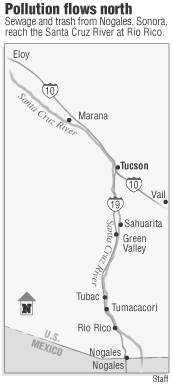

Tucson, Arizona Monday, 9 June 2003
|
|
Polluted flow from Mexico washes north, defying an easy rectification
By Ignacio Ibarra
ARIZONA DAILY STAR
NOGALES, Sonora
The raw sewage that overflows into the wash at Barrio Ferrocarril is just yards from where children play.
It then flows through about 100 yards of a garbage-littered stream bed, drifting past household trash, construction debris, discarded tires, an overturned car and piles of unrecognizable goo before disappearing under a cover of concrete and asphalt.
When the sewage re-emerges in Nogales, Ariz., the flow goes into the Santa Cruz River, which travels north through Rio Rico, Tubac, Green Valley and on to Tucson. In the next few weeks, more of the dirty flow will head north when monsoon season starts.
| Renee Sauer / Staff Resident Julia Gonzales, like many others in Nogales, Sonora, lives close to the polluted, foul-smelling wash. |
Officials in the U.S. and Mexico say elevated counts of fecal coliform bacteria in the Nogales Wash caused by frequent sewer discharges from Nogales, Sonora's, antiquated collection system are a major public health concern.
For more than a decade, the U.S. government has spent about $50,000 a year to treat sewer discharges in Mexico before the water reaches the U.S.
But funding for long-term solutions, like construction of a $59 million international wastewater treatment plant and improvements to distribution infrastructure on both sides of the border, have been bogged down in negotiations among the half-dozen cross-border agencies.
U.S. and Mexican officials insist that drinking water - at least in the U.S. - is unaffected.
"It's horrible living with it - the smells, the garbage. We complain . . . but nothing ever happens," said Maria Isabel Lopez of life on the banks of the Nogales, Sonora, wash.
The wash is the primary drainage channel for this border city of 350,000 people
The mosquitoes are already thick in the weeds growing along the wash, and the pungent smell of sewage and decay fill the air a mile farther south, in Colonia Lomas de Nogales 2.
That's where Isabel Armenta Cital worries about the recurring low-grade fever her 10-month-old baby has had.
Residents on both sides of the border additionally worry about hidden, toxic content of the flow |
"I think it's from the mosquitoes, with dengue and all the other diseases that they carry. That's a big problem, that and all the toxic things the water carries," she said. "When it rains, the water runs red one minute, then green or blue. No one knows what's in the water.".
On the Mexico side, the fecal coliform bacteria routinely exceeds the U.S. standard of 4,000 units. An aggressive, U.S.-funded chlorinization program drops the count to well below 100 units at the border, said Steve Tencza, the top official in southern Arizona for the International Boundary and Water Commission.
By the time the water reaches the international sewage treatment facility that he manages nine miles north of the border at Rio Rico, Tencza says, the fecal coliform count exceeds the federal safety standard. That's due to a leaky U.S. sewage collection system along the wash and the Santa Cruz River.
Tencza said that in addition to the disinfection program in Mexico, nearly $3 million has already been spent there assisting with the replacement of major sewage lines, construction of manholes and other infrastructure improvements. The U.S. government also donated two vacuum trucks worth nearly $400,000 to Nogales, Sonora, that are used to keep sewer lines clear.
Similar expenditures were made for infrastructure on the U.S. side.
When the rain comes, the water flow in the Nogales Wash jumps from 3 cubic feet per second - or about 1.5 million gallons a day - to more than 4,500 cubic feet per second - or more than 2.25 billion gallons a day.
"That's when all of the sewage is going to flow into the lowest point: the Nogales Wash. And it's going to flow on both sides of the border," said Tencza. "When the rain starts, the chlorine stops because it is ineffective because there's so much organic material in the water."
The treatment plant only receives water through the formal sewer collection system, but during the rainy season, the plant routinely exceeds its 17 million-gallon-a-day treatment capacity. It can see peaks as high as 28 million gallons a day, as water seeps into the deteriorated sewer pipes feeding the 30-year-old plant.
The most recent study, a joint U.S.-Mexico effort funded and published by the U.S. Environmental Protection Agency last year, which monitored 13 water wells in the area, found arsenic, nitrate, fecal coliform and PCE (tetrachloroethylene) at levels above Mexican and U.S. standards.
 |
But investigators concluded that while more monitoring was warranted, the level of threat to U.S. residents in the area was insufficient to warrant spending EPA Superfund money to clean up the problems.
Ben Stepleton, director of the Santa Cruz County Environment Health Department, said the decade-old monitoring and chlorination program run under the authority of the International Boundary and Water Commission addresses the fecal coliform bacteria problem. But the lack of ongoing monitoring for other possible contaminants means "at any given moment, we don't know what's in the wash."
Bertha de Velasquez said she hopes that conclusion is alarming to Nogales' neighbors to the north.
"Of course it's dangerous," said de Velasquez, whom neighbors see as the unofficial mayor of their community about two miles south of the border.
"Even when the foul waters aren't flowing, the excrement and all of the other things are in the dirt, and the wind blows it into the air where we breathe it, and it floats downtown and lands on the tacos your tourists buy on the streets," she said. "Then it keeps going north."
* Contact Ignacio Ibarra at (520) 432-2766 or at nacho1@mindspring.com.